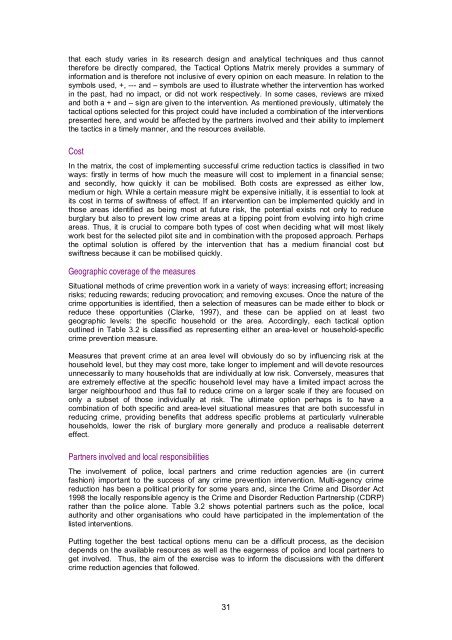Prospective crime mapping in operational context Final report
Prospective crime mapping in operational context Final report
Prospective crime mapping in operational context Final report
- No tags were found...
You also want an ePaper? Increase the reach of your titles
YUMPU automatically turns print PDFs into web optimized ePapers that Google loves.
that each study varies <strong>in</strong> its research design and analytical techniques and thus cannottherefore be directly compared, the Tactical Options Matrix merely provides a summary of<strong>in</strong>formation and is therefore not <strong>in</strong>clusive of every op<strong>in</strong>ion on each measure. In relation to thesymbols used, +, --- and – symbols are used to illustrate whether the <strong>in</strong>tervention has worked<strong>in</strong> the past, had no impact, or did not work respectively. In some cases, reviews are mixedand both a + and – sign are given to the <strong>in</strong>tervention. As mentioned previously, ultimately thetactical options selected for this project could have <strong>in</strong>cluded a comb<strong>in</strong>ation of the <strong>in</strong>terventionspresented here, and would be affected by the partners <strong>in</strong>volved and their ability to implementthe tactics <strong>in</strong> a timely manner, and the resources available.CostIn the matrix, the cost of implement<strong>in</strong>g successful <strong>crime</strong> reduction tactics is classified <strong>in</strong> twoways: firstly <strong>in</strong> terms of how much the measure will cost to implement <strong>in</strong> a f<strong>in</strong>ancial sense;and secondly, how quickly it can be mobilised. Both costs are expressed as either low,medium or high. While a certa<strong>in</strong> measure might be expensive <strong>in</strong>itially, it is essential to look atits cost <strong>in</strong> terms of swiftness of effect. If an <strong>in</strong>tervention can be implemented quickly and <strong>in</strong>those areas identified as be<strong>in</strong>g most at future risk, the potential exists not only to reduceburglary but also to prevent low <strong>crime</strong> areas at a tipp<strong>in</strong>g po<strong>in</strong>t from evolv<strong>in</strong>g <strong>in</strong>to high <strong>crime</strong>areas. Thus, it is crucial to compare both types of cost when decid<strong>in</strong>g what will most likelywork best for the selected pilot site and <strong>in</strong> comb<strong>in</strong>ation with the proposed approach. Perhapsthe optimal solution is offered by the <strong>in</strong>tervention that has a medium f<strong>in</strong>ancial cost butswiftness because it can be mobilised quickly.Geographic coverage of the measuresSituational methods of <strong>crime</strong> prevention work <strong>in</strong> a variety of ways: <strong>in</strong>creas<strong>in</strong>g effort; <strong>in</strong>creas<strong>in</strong>grisks; reduc<strong>in</strong>g rewards; reduc<strong>in</strong>g provocation; and remov<strong>in</strong>g excuses. Once the nature of the<strong>crime</strong> opportunities is identified, then a selection of measures can be made either to block orreduce these opportunities (Clarke, 1997), and these can be applied on at least twogeographic levels: the specific household or the area. Accord<strong>in</strong>gly, each tactical optionoutl<strong>in</strong>ed <strong>in</strong> Table 3.2 is classified as represent<strong>in</strong>g either an area-level or household-specific<strong>crime</strong> prevention measure.Measures that prevent <strong>crime</strong> at an area level will obviously do so by <strong>in</strong>fluenc<strong>in</strong>g risk at thehousehold level, but they may cost more, take longer to implement and will devote resourcesunnecessarily to many households that are <strong>in</strong>dividually at low risk. Conversely, measures thatare extremely effective at the specific household level may have a limited impact across thelarger neighbourhood and thus fail to reduce <strong>crime</strong> on a larger scale if they are focused ononly a subset of those <strong>in</strong>dividually at risk. The ultimate option perhaps is to have acomb<strong>in</strong>ation of both specific and area-level situational measures that are both successful <strong>in</strong>reduc<strong>in</strong>g <strong>crime</strong>, provid<strong>in</strong>g benefits that address specific problems at particularly vulnerablehouseholds, lower the risk of burglary more generally and produce a realisable deterrenteffect.Partners <strong>in</strong>volved and local responsibilitiesThe <strong>in</strong>volvement of police, local partners and <strong>crime</strong> reduction agencies are (<strong>in</strong> currentfashion) important to the success of any <strong>crime</strong> prevention <strong>in</strong>tervention. Multi-agency <strong>crime</strong>reduction has been a political priority for some years and, s<strong>in</strong>ce the Crime and Disorder Act1998 the locally responsible agency is the Crime and Disorder Reduction Partnership (CDRP)rather than the police alone. Table 3.2 shows potential partners such as the police, localauthority and other organisations who could have participated <strong>in</strong> the implementation of thelisted <strong>in</strong>terventions.Putt<strong>in</strong>g together the best tactical options menu can be a difficult process, as the decisiondepends on the available resources as well as the eagerness of police and local partners toget <strong>in</strong>volved. Thus, the aim of the exercise was to <strong>in</strong>form the discussions with the different<strong>crime</strong> reduction agencies that followed.31
















